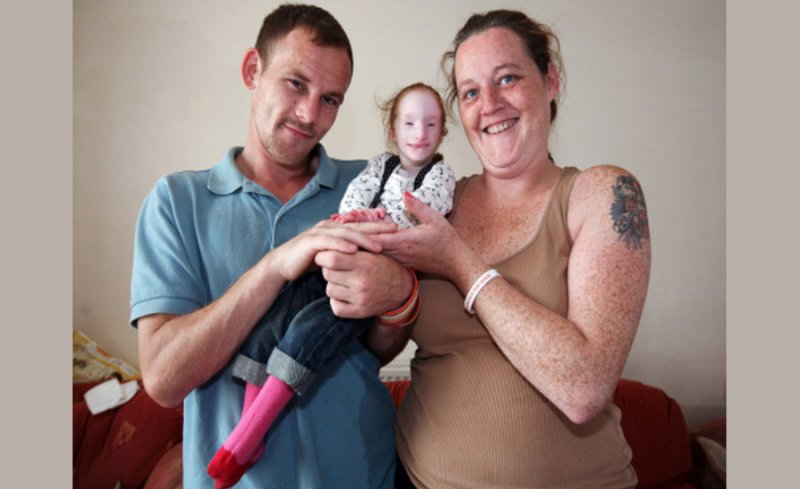Charlotte Garside Age, Height, Net Worth, Parents, Biography

Charlotte Garside, a native of the United Kingdom, holds the remarkable distinction of being the smallest girl in the world. Born in 2007, she quickly gained worldwide attention for her extraordinary stature.
At birth, Charlotte weighed less than a kilogram, a weight that led medical experts to doubt her chances of survival. Yet, against the odds, Charlotte chose to fight. In 2022, she celebrated her 15th birthday, a testament to her resilience.
According to her parents, Charlotte bears a striking resemblance to Thumbelina or a delicate porcelain doll. Standing at approximately 68 cm tall, she is truly petite.
When Charlotte entered the world, she tipped the scales at a mere 0.9 kilos. Though her pregnancy had been progressing normally, she arrived a month ahead of schedule, surprising the doctors. They had initially believed Charlotte’s mother was only 24 weeks pregnant when she was admitted to the hospital, but in reality, she was already 36 weeks along.
Medical professionals had cautioned Charlotte’s parents that she might not survive long after birth. Yet, defying those grim predictions, Charlotte fights valiantly each day, battling against her illness.
Charlotte grapples with primary dwarfism, an exceptionally rare genetic condition that affects just 200 individuals globally. Regrettably, the youngest daughter of her parents inherited this extraordinarily uncommon gene. Thankfully, their other children enjoy robust health.
Charlotte Garside Parents
Charlotte Garside entered the world to the loving embrace of her parents, Scott Garside and Emma Newman. From that very moment, their lives became a dedicated journey of care and support for their special daughter, who was born with a rare form of primordial dwarfism.
This British family stood united, facing every challenge head-on, determined to provide Charlotte with a life that mirrors normalcy. They took on the responsibility of tending to her daily needs, overseeing her education, and shouldering the weight of her medical bills and expenses.
Among her siblings, Chloe, Sabrina, and Sophie, she holds the position of the youngest. In 2012, her story captured the headlines of British tabloids and reverberated around the globe.
Charlotte’s condition stems from an extraordinarily rare form of primordial dwarfism. It’s so uncommon that doctors haven’t even assigned it a name. However, this doesn’t define her. Her vibrant personality shines through, refusing to be overshadowed by her ailment. She’s not one to fade into the background; rather, she exudes a colorful spirit that commands attention.
Charlotte Garside Suffers From Primordial Dwarfism
Primordial dwarfism is an exceptionally rare condition, and Charlotte was born with it. It’s a type of dwarfism that keeps the body unusually small from birth and throughout the growth process. Additionally, she has cysts on her liver and a weakened immune system.
Even in their fetal stage and corresponding age, primordial dwarfs are notably tiny.
Surprisingly, the majority of people aren’t diagnosed until they’re approximately three years old. In addition, many babies born with this disease are smaller at birth.
To assess if the fetus’s small size is caused by gestational age or a problem with growth in the womb, doctors utilise ultrasound.
After birth, growth continues at a slower pace than usual, often stemming from skeletal or endocrine system complications.
Though there are over 200 types of dwarfism, the five subtypes of primordial dwarfism are the most severe. Reportedly, only about 100 people worldwide grapple with this condition.
In North America, studies suggest there are roughly a hundred individuals living with this condition. Unfortunately, those with primordial dwarfism typically don’t exceed a life expectancy of thirty years, at best.
Those with microcephalic osteoplastic primordial dwarfism type II face a higher risk of vascular tissue damage, potentially leading to earlier mortality.
Upon Charlotte’s birth, physicians conveyed to her parents the sobering possibility that she might not see another year.
Yet, against the odds, she defied expectations and now thrives as a spirited and inquisitive young girl.
Charlotte Garside – Where Is She Now?
Charlotte Garside was globally recognized as the smallest girl in the world. After rumors of her passing in January 2022 circulated on various social media platforms, there was a surge of discussions about her.
It seemed that only false information and gossip were spreading rapidly on social media, much like a wildfire sweeping through a forest.
Numerous reports emerged with conflicting accounts of her situation, yet there were no official statements about her current state.
The reality was that nobody knew what had happened to her or whether she was still alive.
According to reports, Charlotte suffered from primordial dwarfism, a potentially life-threatening condition affecting her overall health significantly.
This condition prevented her from attaining the same height as other children, earning her the title of the world’s shortest girl.
There was intense curiosity about her whereabouts and the events surrounding her since reports of her departure began circulating within the community.
However, it wasn’t possible to confirm her passing based on these reports, as sources were still seeking additional information about the situation.
A Reddit post about Charlotte Garside garnered attention, and some noteworthy comments are outlined below.
One user, libra00, shared their own experience, “I had dwarfism (the hormone-deficiency variety), and I’m 5’10”. I received human growth hormone therapy in the 80s – I had to get a shot every day for about 2 years to reach a normal height, but it was totally worth it.”
Comfortable-Worry-84 provided intriguing information, “(Human Growth Hormone), HGH treatment is used these days for young people who are radically below normal growth. It can increase height by a foot or more.”
However, a Reddit user named peoplegrower disputed this, explaining:
“Unless you are lacking in it, it doesn’t actually affect your height. My two children lack enough growth hormone. Around 8 or 9 months old, they stopped growing normally. They were still wearing 12-18m clothing by the time they were 3 years old. To enable them to fulfil their genetic potential, which is probably going to be near to their mid-parental height expectation, they take injections every night. We can’t just “give them a few extra inches,” since they won’t just grow into giants. In order for them to achieve their genetic potential—the height they would achieve if they weren’t GHDeficient—we are replenishing what is lacking. This young lady most likely has GHD in addition to many other problems, so GH therapy may have been beneficial for her, but it’s not something that is just given out randomly to kids who want to grow a little taller so they can play basketball.
Know About Primordial Dwarfism
Primordial dwarfism is an uncommon genetic condition marked by severe limitations in growth and a notably small stature. People affected by primordial dwarfism are considerably smaller than others in their age group and contend with a range of physical and developmental hurdles.
The root cause of this condition lies in genetic mutations that disrupt regular growth and maturation processes. This leads to an imbalance in body proportions and gives rise to various health issues. In this segment, we’ll explore the specifics of primordial dwarfism, covering its origins, signs, methods of diagnosis, and approaches to its management.
Causes
Primordial dwarfism stems mainly from genetic mutations that interfere with the usual operation of genes responsible for overseeing growth. These mutations can arise on their own or be passed down from either one or both parents.
Various forms of primordial dwarfism exist, each tied to particular genetic mutations. Some of the identified genetic mutations connected to primordial dwarfism involve the PCNT, RNU4ATAC, and WRAP53 genes. These mutations hinder the creation or operation of proteins crucial for regular growth.
Diagnosis
Detecting primordial dwarfism requires a thorough assessment of a person’s growth trajectory, physical traits, and developmental progress. To pinpoint the specific genetic mutations linked to primordial dwarfism, healthcare professionals might administer a range of tests, including genetic screening.
Furthermore, imaging procedures like X-rays or bone scans may be employed to scrutinize bone composition and identify any irregularities in the skeletal structure. It’s crucial for individuals with suspected primordial dwarfism to undergo a comprehensive medical examination to guarantee a precise diagnosis.
Symptoms
Primordial dwarfism is characterized by a prominent symptom: severe limitation in growth, leading to individuals being notably smaller than their peers. Typically, adults with primordial dwarfism stand at less than 3 feet (about 91 centimeters) in height. Additional common symptoms encompass:
Disproportionate Body Structure: People with primordial dwarfism often display a small head, shorter limbs, and a relatively larger abdomen in relation to their overall body size.
Developmental Delays: Many individuals with primordial dwarfism experience slower progress in reaching developmental milestones like sitting, crawling, walking, and speaking.
Facial Features: Certain types of primordial dwarfism may exhibit distinct facial characteristics, including a pronounced forehead, a flattened nasal bridge, and a small chin.
Dental Irregularities: Primordial dwarfism often causes crowded teeth, delayed tooth eruption, and misalignments.
Skeletal Abnormalities: Certain people have skeletal deformities like scoliosis or hip dysplasia.
People Also Ask (FAQs)
Who is Charlotte Garside?
UK native Charlotte Garside became famous as the world’s smallest girl. She was born in 2007 with primordial dwarfism, a rare genetic disease.
What is primordial dwarfism?
Primordial dwarfism is an exceptionally rare genetic condition characterized by severe limitations in growth, resulting in individuals being significantly smaller than their peers. It affects various aspects of physical and developmental health.
How small is Charlotte Garside?
Charlotte Garside stands at approximately 68 cm tall, making her exceptionally petite due to her primordial dwarfism.
What was Charlotte’s birth weight?
Medical doctors initially doubted Charlotte’s survival because she weighed 0.9 kilogrammes at birth.
What are the challenges associated with primordial dwarfism?
Primordial dwarfism causes delayed growth, developmental delays, skeletal deformities, liver cysts, and compromised immune systems.
How rare is primordial dwarfism?
Only 200 people worldwide have primordial dwarfism. One of the most severe dwarfisms.
How do doctors diagnose primordial dwarfism?
Diagnosis of primordial dwarfism involves a thorough assessment of growth patterns, physical traits, and developmental progress. Genetic screening and imaging tests like X-rays may be used to identify specific genetic mutations.
What are the causes of primordial dwarfism?
Primordial dwarfism is primarily caused by genetic mutations that disrupt the normal growth processes. These mutations can be inherited or arise spontaneously.






